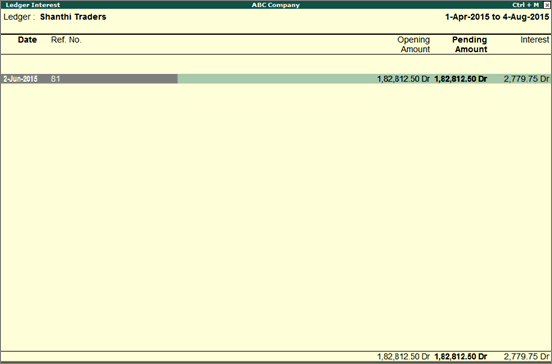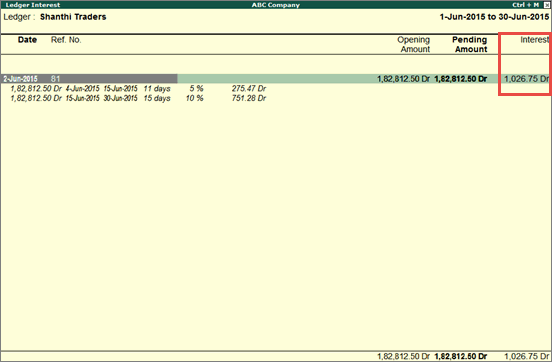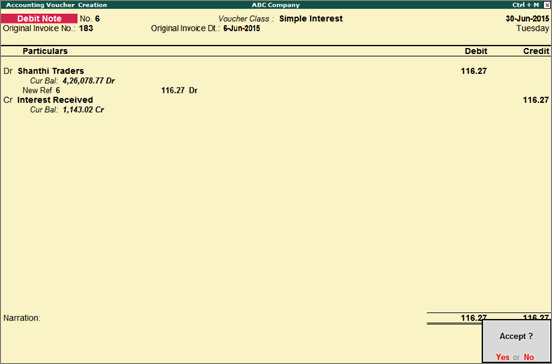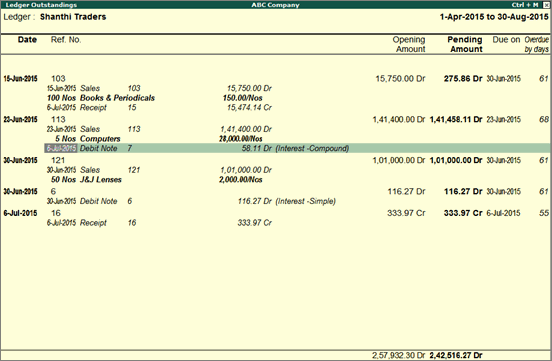
The advanced parameters are used when interest rates change periodically. Number of days, balance type, and applicable from date to be considered for interest calculation can be configured using advanced parameters.
To enable advanced parameters
1. Go to Gateway of Tally > F11: Features > Accounting Features
2. Set Activate interest calculation? to Yes.
3. Set use advanced parameters? to Yes.
4. Press Ctrl+A to accept the changes.
Required options can be selected in the Interest Parameters screen of the party ledger to enable calculation of interest as per your requirement.
To set advanced configuration in Interest Parameters screen of party ledger master
1. Set Calculate Interest Transaction-by-Transaction? to Yes to calculate interest for each transaction.
2. Set Override Parameters for each Transaction? to Yes to display the Interest Parameters screen while recording the transaction. The defined parameters can be modified during voucher entry.
3. Set Override advanced parameters? to Yes.
4. Enter the Rate of interest.
5. Select the interest style, as required. The rate of interest will be calculated on the basis of the interest style applied.
6. Select the balance on which the interest has to be calculated. Interest can be calculated on credit balance, debit balance or both credit and debit balances.
7. Select the Applicability of the interest as required. If Past Due Date is selected, then the number of days after which interest has to be applied can be specified.
8. Select the date from which interest is applicable in the Calculate From field.
9. Select the rounding method applicable in the Rounding field. Select Not Applicable for saving values as is without rounding off.
10. Define multiple slabs with different rates and applicability.
The Interest Parameters screen with multiple slabs appears as shown below:

11. Press Ctrl+A to accept the configuration.
12. Press Ctrl+A to save the ledger.
In case of the above configuration, interest will be calculated at 5% starting from 10th day after due date and at 10% starting from 60th day after due date. Similarly, multiple slabs can be configured with different interest style, applicability, calculate from and rounding.
To view the report on Outstanding balances
● Go to Gateway of Tally > Display > Statements of Accounts > Interest Calculations > Ledgers
● Select the required ledger.

To view the report on Outstanding balances
● Go to Gateway of Tally > Display > Statements of Accounts > Interest Calculations > Ledger > select required ledger
● Click F1: Detailed to view the calculation and period.
Note: In case if part of the amount is settled, the interest is calculated on the remaining balance.

In the party ledger master, set the Interest Parameters for the ledger to calculate from Date Specified During Voucher Entry.
While recording an voucher entry/invoice, record the values as shown below:

To view the interest amount
● Go to Gateway of Tally > Display > Statements of Accounts > Interest Calculations > Ledger

The reports on interest amounts calculated in different ways simple give the interest implications, but these have not been brought into books. The same can be booked using debit or credit note with voucher class.
Use Debit Note for interest receivables and Credit Note for interest payable. Interest is calculated on Simple or Compound basis and separate classes should be used for these.
To create voucher class for booking interest receivable
1. Go to Gateway of Tally > Accounts Info > Voucher Types > Alter
2. Enter the name of the class in the field Name of Class field.
3. Enable the option Use Class for Interest Accounting.

4. Press Ctrl+A to save Voucher Type Class.
5. Press Ctrl+A to save Voucher Type Alteration.
Similarly create a voucher class Compound Interest and set Amounts to be treated as Compound Interest to Yes.
Create a ledger Interest Received under the group Indirect Income for booking the interest value.
There are two situations for interest adjustment:-
● Simple Interest – Interest amounts are not debited onto the same bills. Create a fresh reference for it.
● Compound Interest – Amounts are auto-debited to the selected bills. Bill-wise details will not appear in this case.
or
● Interest on balances only
To create a voucher for booking the interest
1. Go to Gateway of Tally > Accounting Voucher > Crtl+F9: Debit Note
2. Debit the party ledger
o Select the bills to adjust from the List of Interest Bills in the Interest Details screen.

o Press Enter.
3. Select New Ref in the Bill-wise Details screen.
4. Credit the ledger Interest Received grouped under Indirect Income.
The debit note for simple interest appears as shown below:

5. Press Enter to save.
Entries for compound interest are exactly the same as simple interest where all you do is select the voucher class created for compound interest. Also the Bill-wise Details sub-screen is not displayed as the amounts are automatically added onto the bills.
The Ledger Outstandings will be as shown below:

The bill no. 113 is the invoice onto which interest has been compounded.
A new reference no 6 has been created for simple interest due from the party.
Again, the issues are simple and compound interest.
Record the following entries in a debit note with compound interest voucher class.
● Debit bank account (the amount is automatically filled up with the calculated interest)
● Credit Interest Received
The bank account has been increased by the amount of interest due and the income account of Interest Received also credited.
Record the same entry as in case of compound interest, however, since it has the effect of increasing the bank account with the amount due (compound effect), you must make a journal entry to reverse it. The reversal entry would be as shown below:
● Debit Interest Receivable (created under Current Assets group)
● Credit bank account
Use a normal Journal voucher for this entry.
We have to necessarily debit the bank account in first place to take advantage of the auto filling of the interest amount.